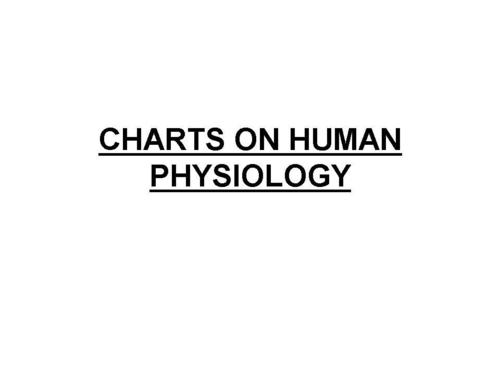Call us now
08045802556

|
CHARTS ON HUMAN PHYSIOLOGY |
|
|
1. Cell Division ( Mitosis). |
14. Maintenance of body temperature. |
|
2. Cell Division ( Meiosis). |
15. Growth. |
|
|
16. Energy requirements and |
|
NUTRITION & METABOLISM |
Energy Expenditure. |
|
|
17. Food facts. |
|
3. Water Cycle |
|
|
4. Carbon Cycle |
CELL MEMBRANE FUNCTIONS |
|
5. Nitrogen Cycle. |
|
|
6. Oxygen Cycle. |
18. Transport through Membranes 1 |
|
7. Vitamin Part 1 & 2 |
Diffusion. |
|
8. Protein Metabolism. |
19. Transport through Membranes II |
|
9. Carbohydrate Metabolism |
Active Transport. |
|
10. Fat Metabolism. |
20. Resting Potential. |
|
11. Energy from food. |
21. The action Potential. |
|
12. Formation of ATP |
22. Propagation of the Nerve Impulse. |
|
13. Heat Balance. |
23. Communication between cells. |
|
24. Second Messangers-I |
EXCRETORY SYSTEM |
|
25. Second Messangers-II |
|
|
|
53. Juxtaglomerular Apparatus. |
|
DIGESTIVE SYSTEM |
54. Urine formation. |
|
|
55. Water absorption Proximal tubule. |
|
26. Swallowing. |
56. Water reabsorption Distal |
|
27. Gastric Secretion and motility. |
& collecting Tubules. |
|
28. Pancreatic Juice. |
57. Maintenance of Acid Base Balance. |
|
29. Liver & Gall Bladder. |
|
|
30. Food absorption by cells of |
ENDOCRINE SYSTEM |
|
the small intestine. |
|
|
31. Movements of the large intestine. |
58. Anterior Pituitary. |
|
32. Innervation of the gut wall. |
59. Posterior Pituitary. |
|
33. Nervous control of gut movements. |
60. Oxytocin. |
|
|
61. ADH in the maintenance of |
|
TRANSPORT SYSTEM |
blood volume. |
|
34. Cardiac Cycle. |
REPRODUCTIVE SYSTEM |
|
35. Cardiac Action Potential. |
|
|
36. Electrocardiogram. |
62. Adult pelvic sex organs in the |
|
37. Cardiac Reflexes. |
ordinary Female cycle. |
|
38. Water Balance. |
63. Ovarian Hormones. |
|
39. Haemostasis and Blood |
64. Pituitary Ovarian and |
|
Coagulation. |
Endometrial Cycles. |
|
40. Factors required for |
|
|
Normal Haematopoiesis. |
CENTRAL NERVOUS SYSTEM |
|
41. Haematopoiesis |
LOCOMOTOR SYSTEM |
|
42. Blood Groups |
|
|
43. Rhesus Factor. |
65. Cranial nerves. |
|
44. Cerebrospinal fluid. |
66. Reflex Action. |
|
|
67. Stretch Reflexes. |
|
RESPIRATORY SYSTEM |
68. Smell. |
|
|
69. Light Reflex. |
|
45. Artificial Respiration |
70. Cochlea. |
|
46. Volume & Capacities of lungs. |
71. Auditory Pathways to brain. |
|
47. Composition of Respired Air. |
72. Vestibular Pathways to brain. |
|
48. Movement of Respiratory Gases. |
73. The Muscle Spindle. |
|
49. Dissociation of Oxygen |
74. Proprioceptor Pathways to brain. |
|
from Haemoglobin. |
75. Peripheral Pain. |
|
50. Uptake & release of Carbon Dioxide. |
76. Posterior Column-Medial |
|
51. Carriage and Transfer of |
lemniscus sensory pathways. |
|
Oxygen & Carbon dioxide. |
77. Anterolateral (Spinothalamic) |
|
52. Voluntary & reflex factors in the |
sensory Pathways. |
|
regulation of respiration. |
78. Sensory Pathways from skin of face. |
|
79. Sensory Cortex. |
90. Skeletal Muscle and the |
|
80. Motor Cortex. |
mechanism of contraction. |
|
81. Motor pathways to head & Neck. |
91. Skeletal Muscle-Molecular |
|
82. Direct(Pyramidal) motor Pathways to |
basis of contraction. |
|
Extremities. |
|
|
83. Indirect (Extrapyramidal) pathways. |
AUTONOMIC NERVOUS SYSTEM |
|
84. Final common Pathways. |
& CHEMICALTRANSMISSION |
|
85.Pathways controlling Motor Activity. |
AT NERVE ENDINGS: |
|
86. Motor Unit. |
|
|
87. Cerebellum Part 1 & 2 |
92. The Autonomic Nervous system. |
|
88. Control of Muscle Movement. |
93. Autonomic Ganglia. |
|
89. Reciprocal Innervation. |
94. Parasympathetic Outflows. |
|
|
95. Autonomic Reflex. |
